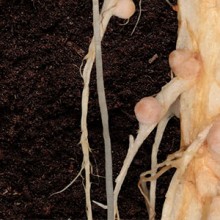Unexpected Complexity: A Three-dimensional Look into Plant Root Relationships with Nitrogen-fixing Bacteria
Original source: https://www.emsl.pnnl.gov/emslweb/news/unexpected-complexity-three-dimensional-look-plant-root-relationships-nitrogen-fixing-bacteria.
Scientists develop a three-dimensional molecular map of the distribution of bacterial metabolites in root nodules to aid sustainable agriculture.

The Science
By fixing atmospheric nitrogen, some bacteria are able to help plants like beans, peas, and clovers thrive. How? A recent study shows that the traditional view of this symbiotic relationship does not capture the entire picture. Scientists have resolved a three-dimensional map of the metabolic products of bacteria found in plant root nodules. This spatial perspective could help unravel the overall complexity of these highly interdependent organisms.
The Impact
As nitrogen-fixing bacteria in soil interact with legumes like soybeans, nodules grow on the roots of the plant. In these nodules, bacteria convert atmospheric nitrogen into molecules the plants need to grow. Understanding the metabolic processes occurring within these nodules is essential to develop more sustainable agricultural practices for food crops used all over the world.
Summary
Previous studies led scientists to believe the distribution of bacterially-derived metabolic by-products within the nodules was uniform. Scientists from EMSL, the Environmental Molecular Sciences Laboratory, a U.S. Department of Energy Office of Science user facility, joined with colleagues at the University of Missouri and the George Washington University to dig deep into the metabolic structure of soybean root nodules. They used one of EMSL’s high-field Fourier transform ion cyclotron resonance mass spectrometers to visualize the array of metabolites within the nodules. Of the approximately 140 regulating substances identified, some were located together in distinct anatomical compartments. A few, however, were more unevenly distributed throughout the middle of the nodule, where the bacteria reside. This discovery points to a previously unrecognized biochemical complexity in the nodules that are key for symbiotic plant-microbe interactions. Armed with this understanding, scientists can suggest ways to optimize crop production and sustainability.
PI Contact
Christopher Anderton
EMSL
Christopher.Anderton@pnnl.gov
Funding
This work was supported by the U.S. Department of Energy’s Office of Science (Office of Biological and Environmental Research), including support of the Environmental Molecular Sciences Laboratory (EMSL), a DOE Office of Science User Facility; the U.S. Department of Energy’s Mickey Leland Energy Fellowship; and the National Science Foundation Plant Genome Program.
Publication
D. Veličković, B.J. Agtuca, S.A. Stopka, A. Vertes, D.W. Koppenaal, L. Paša-Tolić, G. Stacey, and C.R. Anderton. “Observed metabolic asymmetry within soybean root nodules reflects unexpected complexity in rhizobacteria-legume metabolite exchange.” The ISME Journal (2018). DOI: https://doi.org/10.1038/s41396-018-0188-8

